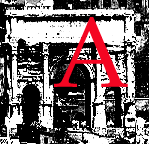In transcribing the following paragraphs from the Internet Archive online version of The Imperial Gazetteer’s entry on Egypt I have divided the long entry into separate documents, expanded abbreviations for easier reading, and added paragraphing and links to material in the Victorian Web. Unless otherwise noted, charts and illustrations come from the original Gazetteer. — George P. Landow


lexandria, an ancient city and seaport in Egypt, lies about 14 miles West of the most West mouth of the Nile, on the ridge of land between the sea and the bed of the old Lake Mareotis; latituude (Point Eunostos) 31˚ 11' 30" North; longitude 29˚ 51' 5" East (R.)
The ancient city of Alexandria was founded 332 years B.C., on the site of a small town called Racotis, by Alexander the Great, who gave it his own name. As the site of a great commercial city, the situation was well chosen, presenting a probability, afterwards fully realized, of uniting the traffic of Europe, Arabia, and India. Of the ancient city, the plan of which was drawn out by Dinocrates, a celebrated architect of antiquity, little else than a wide series of ruins now remains. It stood a little to the South of the present town, and was of great extent, having a circumference of 15 miles, with a pop. of 300,000 free inhabitants, besides, at least, an equal number of slaves. Its magnificence was so remarkable, that the Romans ranked it next to their own capital; and Amer, general of the caliph Omar, in his letter to the latter after the capture of the city, A.D. 640, thus speaks of it: "I have taken the great city of the West. It is impossible for me to enumerate the variety of its riches and beauty, and I shall content myself with observing, that it contains 4000 palaces, 4000 baths, 400 theatres, or places of amusement, 12,000 shops for the sale of vegetables, and 40,000 tributary Jews." (Gibbon.)
The city was regularly built, and traversed by two principal streets, each 100 feet wide, and one of them 4 miles long. One-fourth of the entire area on which it was built, was covered with temples, palaces, and public buildings. Under the Caesars, it attained an extraordinary degree of prosperity; large fleets of merchant vessels traded with India and Ethiopia, and returned laden with the most valuable productions of these countries, to be afterwards distributed through Egypt and other lands. An industrious population improved the general welfare. The inhabitants have been accused of an extraordinary irascibility, which led, on the slightest occasions, to disturbances of the most serious character; but it is more than probable that this proneness to tumult and riot had its origin with, if it was not confined to, the idle, mercenary troops, of which great num bers were always quartered in the city, and who were ever, says Wilkinson, more ready to govern than obey.
The weaving of linen, and the manufacture of glass and papyrus, were the chief occupations of the industrial population of the ancient city. The most remarkable remains of the Alexandria of former times are the famous obelisks, known by the name of Cleopatra’s Needles. These obelisks, of which there are two, are of red granite, and about 70 feet high, with a diameter at the base of about 7 feet. One only is now standing; the other lying prostrate at the foot of it.* [*This obelisk, which had been entirely buried in the sand during the erection of the new fortifications round the city, has been recently brought to light againches It belongs to the British Government, to which it was presented by Mehemet Ali.] Pompey’s, or, more properly, Diocletian s pillar, stands on an eminence about 1800 feet to the South of the present walls. Its total height is 98 feet 9 inches; circumference, 29 feet 8 inches; diameter at the top of the capital, 16 feet 6 inches.
In a hollow space to the Southwest of this column, is the site of an ancient circus. About a mile West of the pillar, and without the walls of the ancient city, are the catacombs, now in a ruinous state, but still sufficiently impressive. They are of great extent, and present some beautiful specimens of architecture. Fragments of columns, and other ruins, scattered over a wide space, with traces of walls, vestiges of public baths, and noble edifices of various descriptions, all bear evidence of the grandeur and mag nificence which had characterized this great city of the East. [1.79]
Related material
Bibliography
Blackie, Walker Grahamiles The Imperial Gazetteer: A General Dictionary of Geography, Physical, Political, Statistical and Descriptive. 4 vols. London: Blackie & Son, 1856. Internet Archive. Inline version of a copy in the University of California Library. Web. 31 July 2020.
Last modified 31 July 2020